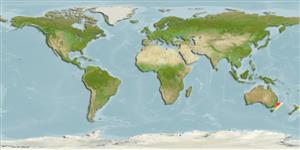分類 / Names
俗名 | 同種異名 | Catalog of Fishes(屬, 種) | ITIS | CoL | WoRMS | Cloffa
Elasmobranchii
板鰓亞綱 (鯊魚與魟魚) (sharks and rays) >
Squaliformes (Sleeper and dogfish sharks)
角鯊目 (Sleeper and dogfish sharks) >
Squalidae (Dogfish sharks)
棘鮫科 (Dogfish sharks)
Etymology: Cirrhigaleus: Latin, cirrus = curl fringe + Greek, galeos = a shark (Ref. 45335); australis: Derived from the Latin australis in reference to the distribution of this species in the temperate
Southern Hemisphere..
More on authors: White, Last & Stevens.
Environment: milieu / climate zone / depth range / distribution range
生態學
海洋; 深度上下限 360 - 640 m (Ref. 58894). 溫帶; 33°S - 42°S
Pacific Ocean: Temperate waters of eastern Australia, and possibly New Zealand (Ref. 58894).
太平洋: 澳洲東部的溫帶水域, 與可能地紐西蘭.(參考文獻 58894)
大小 / 重量 / 年齡
Maturity: Lm ? range ? - ? cm
Max length : 123.0 cm TL (female)
簡短描述
型態特徵 | 形態測量圖
A moderately large dogfish of the genus Cirrhigaleus: body very robust, eyes relatively small, upper labial furrows relatively short, first dorsal fin moderately large, slightly raked, second dorsal similar in size to first dorsal fin, raked, first dorsal spine long, its apex located just below apex of fin; second dorsal spine long, its apex located at about level of fin apex; pectoral fins moderately large, flank denticles with three primary cusps, lateral cusps often with cusplets; 50 monospondylous centra,
85 precaudal centra, 114–115 total centra (Ref. 58894).
一隻本屬 Cirrhigaleus 的普通大狗鯊: 身體非常結實的, 眼相當小又上面的唇溝相當短的, 第一背鰭普通大的, 些微地搜索, 第二背鰭相似的在大小方面對被搜索的第一背鰭, 第一背鰭棘長的, 在鰭的尖頂正下方被設置的它的尖頂; 第二背鰭棘長的, 它的尖頂位於了到處鰭尖頂的水平; 胸鰭普通大的, 側面細齒有三條初期的尖頭, 側面的尖頭通常有 cusplets; 50個 monospondylous 中心,
85個尾前椎中心, 114-115個總中心.(參考文獻 58894)
Life cycle and mating behavior
成熟度 | 繁殖 | 產卵場 | 卵 | 孕卵數 | 仔魚
太平洋: 澳洲東部的溫帶水域, 與可能地紐西蘭.(參考文獻 58894)
White, W.T., P.R. Last and J.D. Stevens, 2007. Cirrhigaleus australis n. sp., a new Mandarin dogfish (Squaliformes: Squalidae) from the south-west Pacific. Zootaxa 1560:19-30. (Ref. 58894)
人類使用
更多資訊
俗名同種異名新陳代謝捕食者生態毒物學繁殖成熟度產卵場產卵群集孕卵數卵卵發育
年龄/大小成長長度-重量長度-長度長度-頻率形態測量圖型態特徵仔魚稚魚動力學入添量豐度BRUVS
參考文獻養殖養殖資訊品種遺傳學Electrophoreses遺傳率疾病加工NutrientsMass conversion
合作者照片Stamps, Coins Misc.聲音神經毒速度泳型鰓區Otoliths腦重體重比眼睛色素
工具
特別的報告
下載 XML
網路資源
Estimates based on models
Preferred temperature (Ref.
123201): 2.7 - 6.5, mean 3.4 °C (based on 12 cells).
Phylogenetic diversity index (Ref.
82804): PD
50 = 0.6250 [Uniqueness, from 0.5 = low to 2.0 = high].
Bayesian length-weight: a=0.00355 (0.00171 - 0.00737), b=3.10 (2.92 - 3.28), in cm total length, based on LWR estimates for this (Sub)family-body shape (Ref.
93245).
營養階層 (Ref.
69278): 4.3 ±0.6 se; based on size and trophs of closest relatives
回復力 (Ref.
120179): 非常低的, 最小族群倍增時間超過14 年 (Preliminary K or Fecundity.).
Fishing Vulnerability (Ref.
59153): High to very high vulnerability (74 of 100).
